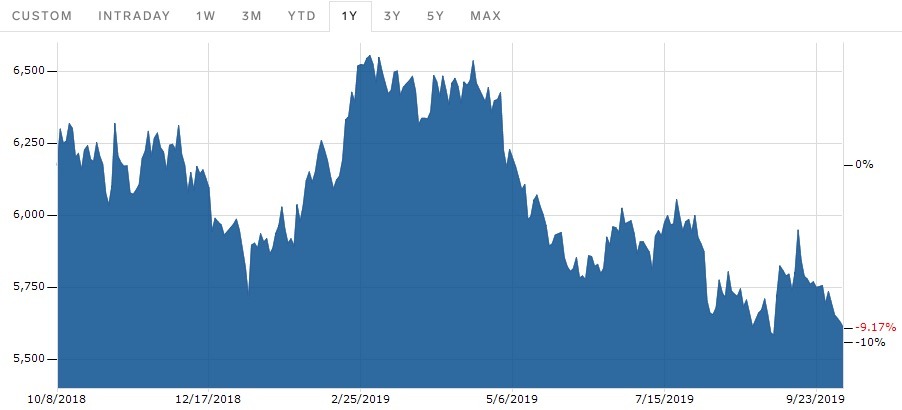A couple of recent stories reported in the Financial Times have put the price of copper in the spotlight.
On the 4th October Neil Hume wrote about how the supressed price of copper, at close to a two-year low of $5,635 per tonne, was due in part to negative metrics around global trade. Copper has a broad spread of industrial uses, and is used in most construction projects, white goods, technology and IT infrastructure projects. This explains why the price of copper is seen by many as a health indicator for the global economy.

Copper price as a proxy for global manufacturing
Global manufacturing activity continues to deteriorate as the US-China trade war grinds along. Recent surveys showing US manufacturing dropping to a ten-year low in September, whilst a seven-year record drop in the Eurozone has also been seen.
“Commodity investors are very [negative] and appear to assume the worst. The recent data supports this view,” said Richard Knights, an analyst with London-based brokerage Liberum.
The immediate future shows no sign of an improvement. Citigroup are estimating demand for copper will increase by just 0.2 per cent in 2019. Whilst Deutsche Bank analyst Nick Snowdon pointed out that higher prices for copper would have been the usual reaction to the near 2 per cent fall in global mine supply over the last year. However, “sluggish demand” outside of China, coupled with a significant reduction in the country’s inventory has “limited the tightening effects for most of the year.”

Whilst you can argue about how exactly we got here, we are where we are, so where next?
John Dizard, also writing in the FT, questions why, when copper plays such a critical role in the global decarbonisation process the world is moving towards, nobody seems willing to buy the copper required?
Your views on climate change and to what extent we need to intervene become moot when even the Russian government is making noises about signing the Paris climate accords and oil companies appear to be in the business of green energy production rather than finding large reserves of thick brown hydrocarbons in the earth.
Mr Dizard makes the clear point that wind and solar power generation and storage required 3 to 15 ties as much copper per unit of output as fossil fuel generation. And what companies like Tesla can fiddle to some extent with the formula of their batteries, tweaking the amounts of cobalt or nickel depending on availability and market prices, copper performs its job too well to be engineered out of the chain, nothing else touches it for strong, durable heat and electricity conduction at this price.
The current price of $5,600 a tonne isn’t sufficient to draw investment to new mines. This is obviously critical for junior mining companies.
“Junior mining is dead”
As Jeffrey Christian, chief executive of CPM Group puts it: “Junior mining is dead. I have been running CPM Group for 33 years, and for 32 of those years we were talking to people about investing in mining companies or metal. Now institutional and retail investors are simply not investing in junior mining companies, because they have lost money at it for so long.”
This assumes the projected flat curve for the price of copper is followed. Paul Gait and other mining analysts at Bernstein have been taking a look what copper prices need to reach in order to adequately finance new mines. “We believe copper needs to be priced at $8,800/tonne, or a 40 per cent uplift, to meet the government-agreed 2030 targets for decarbonisation.”
Not high enough for you? Going to the extreme ‘Greta Scenario’ of complete decarbonisation by 2025 would see prices reach $20,000 a tonne according to Mr Gait and his team.
Mr Gait goes on to say that even keeping production close to today’s level will be a challenge as the industry faces an enormous decline rate from existing, depleting reserves. “Mine supply has grown at 2.5 per cent and 3 per cent per annum forever. To accelerate beyond that for an industry the size of copper mining would be a hell of an undertaking.”
Is what we’re seeing her any different to the cycles we’ve seen previously in the mining industry? Perhaps this increased demand for copper we see coming from the ‘clean energy’ revolution is a lever we haven’t seen pressed so far so quickly before. Change will have to come, but how quickly, and by how much, is to be seen.










